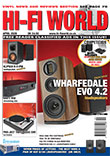Noise |
|
Noise from a VHF/FM tuner at full quieting measures -69dB, with IEC A weighting and IEC Tuner filter applied. WHAT IT TELLS US Noise is a measure of hiss and hum. Noise in the form of hiss is very low in modern AV receivers, well below audibility, measuring lower than -80dB. The highest noise figures are via the input ADCs on the analogue inputs, but with noise figures typically of -86dB hiss is still not audible. The VHF/FM tuner section within most receivers can produce hiss, especially if the aerial signal is weak. VHF/FM tuners need at least 1mV for hiss to hit a minimum and in most locations this demands an outdoor aerial. A hiss level of -62dB will be just audible, but a good VHF section can manage -70dB and will be hiss free. 
HOW WE MEASURE IT We measure hiss level relative to full output, using IEC A weighting. The amplifier’s input is shorted to ground with a shorting plug and the volume control adjusted until hiss is at a maximum, usually at full volume with digital volume controls. Weighting is used to avoid the noise figure being dominated by small amounts of hum.
Measuring noise from the VHF/FM section is complicated by the presence of 19kHz pilot tone. We use our own design external mpx filter to eliminate pilot tone from IEC A weighted noise, measured with the tuner in full quieting at a few millivolts. An alternative is an IEC tuner filter within the Rohde & Schwarz UPL analyser. Tunable notch filters remove heterodyne whistles.
We measure phono stage noise using a short circuited input and divide output noise by gain at 1kHz to derive an equivalent input noise figure. IEC A weighting is used. Noise values obtained by this method are typically around 0.6uV. |







